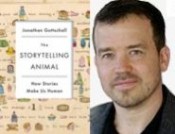NEW Free Forum RANDY OLSON – Use Narrative to Connect & Move People – ExhibitA: Trump
Written on September 21st, 2017RANDY OLSON, marine biologist turned filmmaker, author of DON’T BE SUCH A SCIENTIST and HOUSTON, WE HAVE A NARRATIVE says we’re all receiving a firehose of information and can no longer deal with all the separate bits, so we look for higher levels of organization. We look for narratives. Get on board if you want to impact society. PS His Narrative Index predicted Trump’s victory.
http://www.randyolsonproductions.com/
http://www.scienceneedsstory.com
http://www.shiftingbaselines.org
Q&A: JONATHAN GOTTSCHALL, Author – THE STORYTELLING ANIMAL: How Stories Make Us Human
Written on May 23rd, 2014 |
Aired 12/02/12
Last July in an interview with Charlie Rose, President Obama said that “the mistake” of the early years of his presidency was his failure to be a better storyteller.
“The mistake of my first couple of years was thinking that this job was just about getting the policy right. And that’s important, but the nature of this office is also to tell a story to the American people that gives them a sense of unity and purpose and optimism, especially during tough times.” In a second term, he said, he would “spend more time with the American people, listening to them, but also being in a conversation with them about where do we go as a country?”
This week’s show is not about Obama or politics. It’s about story and narrative. My guest is JONATHAN GOTTSCHALL author of THE STORYTELLING ANIMAL.
The late evolutionary biologist Steven Jay Gould called humans “the primate who tells stories…” And it’s not just Gould. Anthropologists have found societies that have existed for millennia without the wheel, but they’ve never found one that doesn’t tell stories.
My website leads with a quote: “On the radio, I tell stories of a world that just might work. As a consultant, I help you tell yours.” Building on time as a teacher, two decades in the entertainment industry, and 15 years of radio interviews, I help non-profits, foundations, public agencies, and businesses to tell better stories and build better narratives.
I’m eager to learn from Jonathan what the latest science has to tell us. Why is narrative so powerful? What is its evolutionary value? And can what we’re learning help us get even better at tapping its power?
Free Forum Q&A: TERRENCE McNALLY Turning the tables, my turn to answer Qs interviewed by Sara Davidson
Written on February 4th, 2014 |
Aired: 2/2/14
I am going to take a hiatus from this show in a few weeks, for the first time in 17 years. I need to focus on some other projects, including a book I’m writing, and won’t be able to afford the time to produce and host this show probono.
In anticipation of this upcoming break, I will be the guest this week and SARA DAVIDSON, best-selling author of Loose Change and Leap, whose new book, The December Project will come out in March, will be interviewing me. I’ve long thought it is only fair that I have to answer a few questions and this week it’s going to happen.
We tell ourselves stories — as a year ends, a year begins
Written on January 4th, 2012We tell ourselves stories — as a year ends and the next begins
We look back. Have we been naughty or nice? What were the Ten Best…? Did I fulfill my goals? How much older do I look? How much older do I feel? What did I learn? What did I accomplish? What did I screw up?
What did I lose?
All stories, narratives: This is what happened and this is what it meant. This is what happened and this is what we learned.
Reflections. In the mirror and in the past.
We do it as individuals, we do it as a society, and we do it everywhere in between. As a company, any organization or team, a family, a relationship.
Though calendars vary, the death and birth of the year occurs at the end of the last of twelve cycles rooted in the movement of heavenly bodies, and in the days, nights, and seasons of nature.
We look forward. We set goals. We make up lists. We even write them down and talk about them. When else do we make resolutions? We develop plans and budgets. We go on diets. We join clubs.
Narratives again: This is what I predict will happen, this is what I hope will happen, this is what I fear will happen. And this is why, and what it might mean. Stories that haven’t happened yet.
We dream. We imagine the future at the start of the year more than at any other time.
Seeing and Speaking in Narrative
Written on November 12th, 2011The train is rolling by. I’m in my room at the Holiday Inn Capitol in DC and the tracks run right outside my window. The hum communicates enormous weight and power in rhythm punctuated by occasional quick squeals and now and then a whistle moan. Early this morning it half woke me several times. Tonight it sounds beautiful.

I taught a workshop on story and narrative today. One of my top three criteria for a good story is “at least one flesh and blood character”. I emphasize the importance of a protagonist and recommend giving people a human being to identify with, follow, root for, etc. — rather than an organization or an idea
That’s all true and good advice, but it is equally valuable to be able to see and communicate in narratives when the protagonist is not an individual. When it is a team or an organization; an idea, a cause or even a piece of legislation. I contend that looking for narratives and our roles in them is simply a wise way to approach life. We see and feel things and make connections we might otherwise miss.
On top of that, the ability to communicate in narratives pays off in all sorts of ways. People understand narratives and identify with them. Narratives engage. And when you speak in narratives, you’ve got a chance to frame the conversation.
Ira Glass defines the recurring sequence in all This American Life stories: “Then this happens, then this happens, then this happens, and this is what it means. Then this happens, then this happens, then this happens, and this is what it means.”
There’s a narrative to who your organization is. There’s a narrative to how you’ve evolved your mission. There’s a narrative to your biggest achievements. There’s a narrative to what you’re fighting for and what you’re fighting against. There’s a narrative to why your organization is valuable and how it plays an important role in bigger narratives. There’s a narrative to where you want to go in the next year or the next five. In every case it’s basically “Then this happens, then this happens, then this happens, and this is what it means” – or “and this is what we learned.”
Tapping into the unique power of story and narrative calls for both. You want to learn to tell stories of individual human beings with the plot and character arcs that can make such stories sing. And you also want to learn to see and speak in narratives about everything else.
